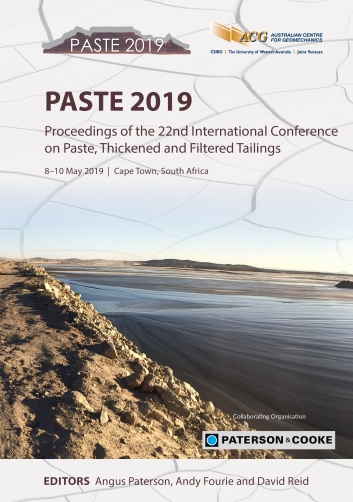Satellite bathymetry for the monitoring of supernatant water volumes within tailings storage facilities

|
Authors: Navarro, L; Aravena, G; Engels, J; Turner, J |
DOI https://doi.org/10.36487/ACG_rep/1910_13_Engels
Cite As:
Navarro, L, Aravena, G, Engels, J & Turner, J 2019, 'Satellite bathymetry for the monitoring of supernatant water volumes within tailings storage facilities', in AJC Paterson, AB Fourie & D Reid (eds), Paste 2019: Proceedings of the 22nd International Conference on Paste, Thickened and Filtered Tailings, Australian Centre for Geomechanics, Perth, pp. 205-217, https://doi.org/10.36487/ACG_rep/1910_13_Engels
Abstract:
The availability of water plays a fundamental role in the operational continuity associated with mineral and metal extraction operations. As part of this process, it is necessary to recover as much water as possible for reuse and reduce make-up water requirements while trying to maintain a reduced impact on the surrounding environment and natural resources. Specifically related to tailings disposal, the past few decades have seen a shift towards high-density tailings with advances in thickening and filtering technologies, thus improving the water recovery and reducing the volumes of water deposited within a tailings storage facility. However, the vast majority of tailings facilities worldwide still generate a supernatant pond as the tailings naturally consolidate and bleed. These ponds need to be controlled in their size and volume, particularly in larger throughput operations. In some countries, it is a requirement to report volume to the authorities on a routine basis. This paper presents a study to monitor the growth of supernatant ponds in tailings facilities using remote sensing techniques. Principally, this relates to a multispectral analysis of satellite bands which, by means of various corrections and applications of combinations of these bands through mathematical algorithms, the depths of relatively shallow supernatant ponds can be determined reasonably accurately. The importance of the study is to provide an alternative to current in situ monitoring techniques, such as sonar instrumentation, which is limited to a minimum depth. The added advantage is that satellite monitoring delivers information quickly and cost effectively and, more importantly, avoids the requirement for human presence, thus reducing operational risks.
Keywords: satellite, spectral band, bathymetry, supernatant water, sonar
References:
Blue Marble Geographics 2017, Global Mapper, computer software, Blue Marble Geographics, Hallowell, www.bluemarblegeo.com
Chybicki, A 2017, ‘Mapping south baltic near-shore bathymetry using Sentinel-2 observations’, Polish Maritime Research, vol. 24, pp. 15–25.
Consumo%20de%20agua%20en%20la%20mineria%20del%20cobre%20al%202017.pdf, in Spanish.
Deidda, M & Sanna, G 2012, ‘Pre-processing of high resolution satellite image for sea bottom’, Italian Journal of Remote Sensing, vol. 44, issue I, pp. 83–95.
ESA 2018c, Sentinel Online: MultiSpectral Instrument (MSI) Overview, European Space Agency, viewed 5 October 2018, msi/msi-instrument
Lyzenga, D 1978, ‘Passive remote-sensing techniques for mapping water depth and bottom features’, Applied Optics, vol. 17, p. 379.
Lyzenga, D 1985, ‘Shallow-water bathymetry using combined lidar and passive multispectral scanner data’, International Journal of Remote Sensing, vol. 6, no. 1, pp. 115–125.
Müller-Wilm, U 2016, Sentinel-2 MSI – Level-2A Prototype Processor Installation and User Manual S2, user manual, European Space Agency.
Siegmund, A & Menz, G 2005, ‘Fernes nah gebracht – Satelliten und Luftbildeinsatz zur Analyse von Umweltveränderungen im Geographieunterricht’, Geographie und Schule, vol. 154.
Stumpf, RP, Holderied, K & Sinclair, M 2003, ‘Determination of water depth with high-resolution satellite imagery over variable bottom types’, Limnology and Oceanography, vol. 48, issue 1, part 2, pp. 547–556.
© Copyright 2025, Australian Centre for Geomechanics (ACG), The University of Western Australia. All rights reserved.
View copyright/legal information
Please direct any queries or error reports to repository-acg@uwa.edu.au
View copyright/legal information
Please direct any queries or error reports to repository-acg@uwa.edu.au


